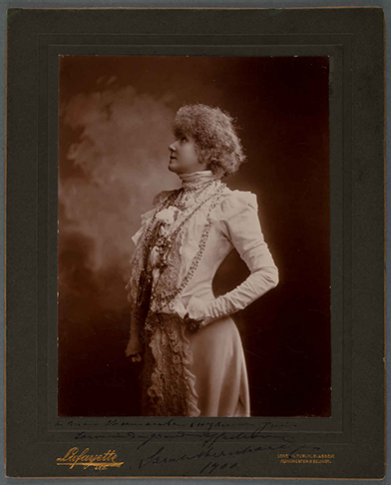About
Aristotype
Aristotypes are part of the direct darkening processes known as “three-layer” techniques: a paper support, a layer of barium sulfate (white pigment) mixed with gelatin, and finally an image layer containing silver chloride suspended in gelatin or collodion.

Lafayette, Sarah Bernhardt vers 1900, ca. 1900 © ARCP / Mairie de Paris / Jean-Philippe Boiteux, 2015.
Historical period of production and use
The first aristotype paper was marketed in 1867 by the Munich-born chemist Johann Baptist Obernetter. As the first industrial paper production process it offered many improvements to the practice of photography such as ease of use, because it was ready to use, increased sensitivity and better conservation, which quickly attracted amateur photographers. For all those reasons, during the 1880s this process gradually supplanted the use of albumen paper.
Aristotypes are composed by a three-layer process comprising a paper layer, a layer of baryum sulphate in gelatin and finally a layer of emulsion containing silver chloride suspended in a binder. The use of a baryta layer applied between the paper and the emulsion makes it possible to achieve purer whites and increases the brightness of the image. Being hidden by the baryta layer, the paper fibres are no longer visible.
Fabrication
As it is a Printing-Out Paper process, exposure occurs through contact with the negative in a printing frame, producing a print with identical dimensions to the negative. Before washing, the print is fixed and then toned, usually in a gold chloride bath. Self-toning papers were sold later in the market.
Aristotypes offer very good definition as well as warm tones which vary from red to purplish-brown depending on the type of toning and the nature of the binder used in the preparation of the emulsion. Various binders can be used in the production of the emulsion for this process. While it is often possible to identify binders by examining visually the print, in some cases, such as with hybrid processes, the identification of the binder may require further scientific analysis. The two main types of aristotypes take their names from the two most frequently observed binders in collections, namely collodion and gelatin.
The first, the collodion aristotype, was marketed from 1865 as a result of the work of A. Gaudin who developed the first positive colloidal silver emulsion, otherwise known as celloidin paper.
Enlarged detail x 2 © ARCP / Mairie de Paris / Jean-Philippe Boiteux, 2015.
Enlarged detail x 8 © ARCP / Mairie de Paris / Jean-Philippe Boiteux, 2015.
As it is a Printing-Out Paper process, exposure occurs through contact with the negative in a printing frame, producing a print with identical dimensions to the negative. Before washing, the print is fixed and then toned, usually in a gold chloride bath. Self-toning papers were sold later in the market.
Aristotypes offer very good definition as well as warm tones which vary from red to purplish-brown depending on the type of toning and the nature of the binder used in the preparation of the emulsion. Various binders can be used in the production of the emulsion for this process. While it is often possible to identify binders by examining visually the print, in some cases, such as with hybrid processes, the identification of the binder may require further scientific analysis. The two main types of aristotypes take their names from the two most frequently observed binders in collections, namely collodion and gelatin.
The first, the collodion aristotype, was marketed from 1865 as a result of the work of A. Gaudin who developed the first positive colloidal silver emulsion, otherwise known as celloidin paper.
Credits
Visual Glossary of Photographic Processes © ARCP / Mairie de Paris, 2023
Glossary
